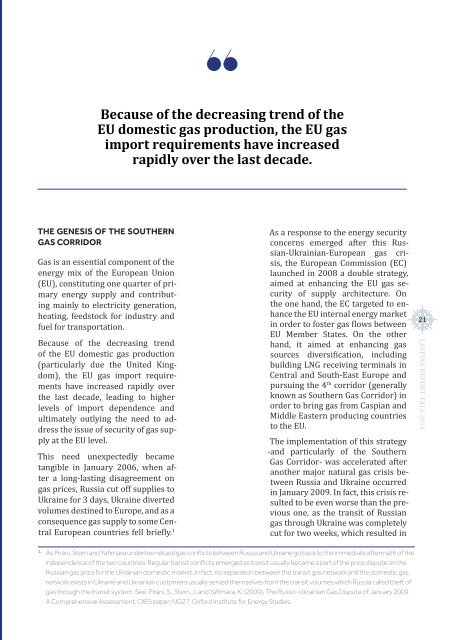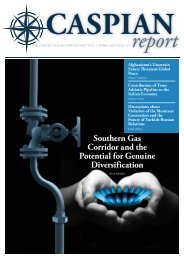You also want an ePaper? Increase the reach of your titles
YUMPU automatically turns print PDFs into web optimized ePapers that Google loves.
Because of the decreasing trend of the<br />
EU domestic gas production, the EU gas<br />
import requirements have increased<br />
rapidly over the last decade.<br />
THE GENESIS OF THE SOUTHERN<br />
GAS CORRIDOR<br />
Gas is an essential component of the<br />
energy mix of the European Union<br />
(EU), constituting one quarter of primary<br />
energy supply and contributing<br />
mainly to electricity generation,<br />
heating, feedstock for industry and<br />
fuel for transportation.<br />
Because of the decreasing trend<br />
of the EU domestic gas production<br />
(particularly due the United Kingdom),<br />
the EU gas import requirements<br />
have increased rapidly over<br />
the last decade, leading to higher<br />
levels of import dependence and<br />
ultimately outlying the need to address<br />
the issue of security of gas supply<br />
at the EU level.<br />
This need unexpectedly became<br />
tangible in January 2006, when after<br />
a long-lasting disagreement on<br />
gas prices, Russia cut off supplies to<br />
Ukraine for 3 days, Ukraine diverted<br />
volumes destined to Europe, and as a<br />
consequence gas supply to some Central<br />
European countries fell briefly. 1<br />
As a response to the energy security<br />
concerns emerged after this Russian-Ukrainian-European<br />
gas crisis,<br />
the European Commission (EC)<br />
launched in 20<strong>08</strong> a double strategy,<br />
aimed at enhancing the EU gas security<br />
of supply architecture. On<br />
the one hand, the EC targeted to enhance<br />
the EU internal energy market<br />
in order to foster gas flows between<br />
EU Member States. On the other<br />
hand, it aimed at enhancing gas<br />
sources diversification, including<br />
building LNG receiving terminals in<br />
Central and South-East Europe and<br />
pursuing the 4 th corridor (generally<br />
known as Southern Gas Corridor) in<br />
order to bring gas from <strong>Caspian</strong> and<br />
Middle Eastern producing countries<br />
to the EU.<br />
The implementation of this strategy<br />
-and particularly of the Southern<br />
Gas Corridor- was accelerated after<br />
another major natural gas crisis between<br />
Russia and Ukraine occurred<br />
in January 2009. In fact, this crisis resulted<br />
to be even worse than the previous<br />
one, as the transit of Russian<br />
gas through Ukraine was completely<br />
cut for two weeks, which resulted in<br />
21<br />
CASPIAN REPORT, FALL <strong>2014</strong><br />
1.<br />
As Pirani, Stern and Yafimava underline natural gas conflicts between Russia and Ukraine go back to the immediate aftermath of the<br />
independence of the two countries. Regular transit conflicts emerged as transit usually became a part of the price dispute on the<br />
Russian gas price for the Ukrainian domestic market. In fact, no separation between the transit gas network and the domestic gas<br />
network exists in Ukraine and Ukrainian customers usually served themselves from the transit volumes which Russia called theft of<br />
gas through the transit system. See: Pirani, S., Stern, J. and Yafimava, K. (2009), The Russo-Ukrainian Gas Dispute of January 2009:<br />
A Comprehensive Assessment, OIES paper: NG27, Oxford Institute for Energy Studies.










